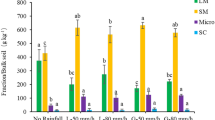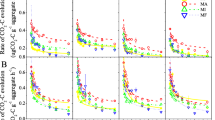Abstract
The fate of persistent organic pollutants (POPs) and their interactions with aggregates of forest soils are not completely understood. Our objectives here were to quantify the distribution of different POPs in water-stable aggregate fractions and to study their influence on soil organic carbon (Corg) content. Soil samples were taken from a forest-site, Gogerddan (G) and a semi-rural site, Hazelrigg (H) in Great Britain, from 0–2 and 2–5 cm and 0–4 and 8–12 cm soil depth, respectively. POPs analyzed were PAHs, PCBs, total DDT, PBDEs and HCB. The bulk soil analysis showed that the concentration of POPs was significantly higher (p ≤ 0.05) in forest site G than in semi-rural site H, particularly at the surface soil levels compared to the subsurface soil depths in both sites. Total concentrations of PCBs and PAHs of both sites were positively correlated with Corg contents. POPs concentrations and Corg, Nt contents of forest site G were significantly higher (p ≤ 0.05) in water-stable macro aggregates (>0.25, >1, >2 mm) than the micro aggregates (>0.053 mm). The POP concentrations of all aggregate fractions after normalizing to their respective Corg content were increased due higher contamination and strong sorption by Corg. These results showed a strong effect of Corg on the partitioning of organic pollutants to soil aggregate size fractions. The present study affirms the ecological significance of forest soils act as a potential sink of POPs. In summary, our results suggest that aggregate fractions may promote soil C storage and act as a potential POP sink in surface soil without increasing their concentration in the aggregate fraction of subsoil.



Similar content being viewed by others
References
Abbas AO, Brack W (2005) Polycyclic aromatic hydrocarbons in Niger Delta soil: contamination sources and profiles. Int J Environ Sci Technol 2(4):343–352
Ashman MR, Hallett PD, Brookes PC (2003) Are the links between soils aggregate size class, soil organic matter and respiration rate artifacts of the fractionation procedure? Soil Biol Biochem 35(3):435–444
Bergknut M, Laudon H, Wiberg K (2010) Dioxins, PCBs and HCB in soil and peat profiles from a pristine boreal catchment. Environ Pollut 158(7):2518–2525
Bergknut M, Wiberg K, Klaminder J (2011) Vertical and lateral redistribution of POPs in soils developed along a hydrological gradient. Environ Sci Technol 45(24):10378–10384
Bu BQ, Zhang ZH, Lu S, He FP (2009) Vertical distribution and environmental significance of PAHs in soil profiles in Beijing, China. Environ Geochem Health 31(1):119–131
Bundt M, Widmer F, Pesaro M, Zeyer J, Blaser P (2001) Preferential flow paths: biological ‘hot spots’ in soils. Soil Biol Biochem 33(6):729–738
Cabrerizo A, Dachs J, Moeckel C, Ojeda MJ, Caballero G, Barcelo D, Jones KC (2011a) Factors influencing the soil-air partitioning and the strength of soils as a secondary source of Polychlorinated Biphenyls to the atmosphere. Environ Sci Technol 45(11):4785–4792
Cabrerizo A, Dachs J, Ojeda MJ, Jones KC, Barcelo D (2011b) Soil-air exchange controls on background atmospheric concentrations of organochlorine pesticides. Atmos Chem Phys 11(24):12799–12811
Cousins IT, Gevao B, Jones KC (1999) Measuring and modelling the vertical distribution of semi-volatile organic compounds in soils. I: PCB and PAH soil core data. Chemosphere 39(14):2507–2518
Gao L, Zhao X, Zheng M, Zhang B, Liu W (2005) Distribution of polychlorinated biphenyls in different depths of soil from a polluted area in the People’s Republic of China. Bull Environ Contam Toxicol 74(5):962–967
Guazzoni N, Comolli R, Binellia A, Tremoladaa P (2013) Environmental variables affecting the distribution of POPs on Mt. Meru, Tanzania. Environ Sci Process Impacts 15(8):1573–1581
Heywood E, Wright W, Wienburg CL, Black HIJ, Long SM, Osborn D, Spurgeon DJ (2006) Factors influencing the national distribution of polycyclic aromatic hydrocarbons and polychlorinated biphenyls in British soils. Environ Sci Technol 40(24):7629–7635
Horstmann M, McLachlan MS (1998) Atmospheric deposition of semivolatile organic compounds to two forest canopies. Atmos Environ 32(10):1799–1809
Huang W, Peng P, Yu Z, Fu J (2003) Effects of organic matter heterogeneity on sorption and desorption of organic contaminants by soils and sediments. Appl Geochem 18(7):955–972
Jasmin KS, Gioia R, Brevik K, Steinnes E, Scheringer M, Jones KC (2010) Trends in European background air reflect reductions in primary emissions of PCBs and PBDEs. Environ Sci Technol 44(17):6760–6766
John B, Yamashita T, Ludwig B, Flessa H (2005) Storage of organic carbon in aggregate and density fractions of silty soils under different types of land use. Geoderma 128(1–2):63–79
Klecka G, Boethling B, Franklin J, Graham G, Grady L, Howard P, Kannan K, Larson R, Mackay D, Muir D, van der Meent K (2000) Evaluation of persistence and long-range transport of organic chemicals in the environment. SETAC Special Publication Series, Pensacola FL
Komprdová K, Komprda J, Menšík L, Vaňková L, Kulhavý J, Nizzetto L (2016) The influence of tree species composition on the storage and mobility of semivolatile organic compounds in forest soils. Sci Total Environ 553:532–540
Krauss M, Wilcke W, Zech W (2000) Polycyclic aromatic hydrocarbons and polychlorinated biphenyls in forest soils: depth distribution as indicator of different fate. Environ Pollut 110(1):79–88
Lohmann R, Breivik K, Dachs J, Muir D (2007) Global fate of POPs: current and future research directions. Environ Pollut 150(1):150–165
Mackay D (2001) Multimedia environmental models. In: The fugacity approach, second ed. Lewis Publishers, Boca Raton, FL, USA doi: http://dx.doi.org/10.1201/9781420032543
Meijer SN, Steinnes E, Ockenden WA, Jones KC (2002) Influence of environmental variables on the spatial distribution of PCBs in Norwegian and UK Soils: implications for global cycling. Environ Sci Technol 36(10):2146–2153
Meijer SN, Ockenden WA, Sweetman AJ, Breivik K, Grimalt JO, Jones KC (2003) Global distribution and budget of PCBs and HCB in background surface soils: implications for sources and environmental processes. Environ Sci Technol 37(4):667–672
Moeckel C, Nizzetto L, Di Guardo A, Steinnes E, Freppaz M, Filippa G, Camporini P, Benner J, Jones KC (2008) Persistent organic pollutants in boreal and montane soil profiles: distribution, evidence of processes and implications for global cycling. Environ Sci Technol 42(22):8374–8380
Nam JJ, Gustafsson O, Kurt-Karakus P, Steinnes E, Jones KC (2008a) Relationships between organic matter, black carbon and persistent organic pollutants in European background soil: implications for sources and environmental fate. Environ Pollut 156:809–817. doi:10.1016/j.envpol.2008.05.027
Nam JJ, Thomas GO, Jaward FM, Steinnes E, Gustafsson O, Jones KC (2008b) PAHs in background soils from Western Europe: influence of atmospheric deposition and soil organic matter. Chemosphere 70(9):1596–1602
Nieman JKC, Kimball DO, McLean JE, Sims RC, Sims JL, Sorensen DL, Rice JA (1998) Humification of pyrene in contaminated soil during land farming. In: Proceedings of the conference on hazardous waste research: bridging gaps in technology and culture, Snowbird, UT, May 18–21, 1998; The Great Plains/Rocky Mountain Hazardous Substance Research Center; Proceedings on the web at http://www.engg.ksu.edu/HSRC/98Proceed/. Accessed 06 Oct 2015
Ockenden WA, Breivik K, Meijer SN, Steinnes E, Sweetman AJ, Jones KC (2003) The global re-cycling of persistent organic pollutants is strongly retarded by soils. Environ Pollut 121(1):75–80
Reichman R, Wallach R, Mahrer Y (2000) A combined soil atmosphere model for evaluating the fate of surface-applied pesticides, 1. Model development and verification. Environ Sci Technol 34:1313–1320. doi:10.1021/es990356e
Ren N, Que M, Li YF, Wan X, Xu D, Sverko ED, Ma J (2007) Polychlorinated Biphenyls in Chinese surface soils. Environ Sci Technol 41(11):3871–3876
Sweetman AJ, Valle MD, Prevedourous K, Jones KC (2005) The role of soil organic carbon in the global cycling of persistent organic pollutants (POPs): interpreting and modelling field data. Chemosphere 60(7):959–972
Tisdall JM, Oades JM (1982) Organic matter and water-stable aggregates in soils. J Soil Sci 33(2):141–163
Valle DM, Jurado E, Dachs J, Sweetman AJ, Jones KC (2005) The maximum reservoir capacity of soils for persistent organic pollutants: implications for global cycling. Environ Pollut 134(1):153–164
Vlčková K, Hofman J (2012) A comparison of POPs bioaccumulation in Eisenia fetida in natural and artificial soils and the effects of aging. Environ Pollut 160:49–56. doi:10.1016/j.envpol.2011.08.049
Wang XC, Zhang YX, Chen RF (2001) Distribution and partitioning of polycyclic aromatic hydrocarbons (PAHs) in different size fractions in sediments from Boston Harbor, United States. Mar Pollut Bull 42(11):1139–1149
Wilcke W, Bäumler R, Deschauer H, Kaupenjohann M, Zech W (1996a) Small-scale distribution of Al, heavy metals, and PAHs in an aggregated alpine Podzol. Geoderma 71(1–2):19–30
Wilcke W, Zech W, Kobza J (1996b) PAH pools in soils along a PAH deposition gradient. Environ Pollut 92(3):307–313
Wilcke W, Krauss M, Safronov G, Fokin AD, Kaupenjohann M (2006) Polychlorinated biphenyls (PCBs) in soils of the Moscow region: concentrations and small-scale distribution along an urban-rural transect. Environ Pollut 141(2):327–335
Yang Y, Tao S, Zhang N, Zhang DY, Li XQ (2010) The effect of soil organic matter on fate of polycyclic aromatic hydrocarbons in soil: a microcosm study. Environ Pollut 158:1768–1774. doi:10.1016/j.envpol.2009.11.010
Yang R, Zhang S, Li A, Jiang G, Jing C (2013) Altitudinal and spatial signature of persistent organic pollutants in soil, lichen, conifer needles, and bark of the Southeast Tibetan Plateau: implications for sources and environmental cycling. Environ Sci Technol 47(19):12736–12743
Zheng Y, Luo X, Zhang W, Wu B, Han F, Lin Z, Wang X (2012) Enrichment behavior and transport mechanism of soil-bound PAHs during rainfall-runoff events. Environ Pollut 171:85–92
Acknowledgements
The collaboration of Dr. Claudia Moeckel, Lancaster University, UK and valuable suggestions of Dr. Bernard Ludwig, Head of Department of Environmental Chemistry, University of Kassel and technical assistance of Anja Sawallisch are profoundly acknowledged.
Author information
Authors and Affiliations
Corresponding author
Additional information
Project funding: The study scholarship was financed by the Higher Education Commission (HEC) of Pakistan and German Academic Exchange Service (DAAD).
The online version is available at http://www.springerlink.com
Corresponding editor: Hu Yanbo.
Rights and permissions
About this article
Cite this article
Maqsood, S., Murugan, R. Distribution of persistent organic pollutants in aggregate fractions of a temperate forest and semi-rural soil. J. For. Res. 28, 953–961 (2017). https://doi.org/10.1007/s11676-017-0380-0
Received:
Accepted:
Published:
Issue Date:
DOI: https://doi.org/10.1007/s11676-017-0380-0




